Miscellaneous
Making a Better World Through Games
0
Gamer on the verge of an epic win
In February 2010, Jane McGonigal gave a TED Talk on how gaming is not only a prominent feature of modern society, but an absolutely essential one. She cites statistics that demonstrate people become engaged in games more than any other activity, and follows up with an argument that has been echoed by educators interested in gaming for awhile: Since deep, immersed engagement is present in game playing, why not use games for learning?
McGonigal identifies four common aspects of gamers that can be called the “habits of heroes,” or traits successful real-life problem-solvers possess:
- Urgent optimism: Gamers believe in instantaneous action to solve problems. It is not always necessary that a deadline must be looming in the background, or that a time-sensitive result must be attained. Gamers tend to believe in prompt action to solve the game world problems.
- Social fabric: Gamers trust the community. Strong social bonds are formed particularly through multi-user game playing, raiding, questing, and adventuring. This cohesion forms relationships of dependence and reliability that are essential to group work.
- Blissful productivity: Gamers are happier to work hard at solving the problems in a game. And in conjunction with the large groups of people available in the game, a diversity of skills can be pooled together to tackle the problems.
- Epic meaning. Gamers desire to become involved in a common cause. The gamers believe in what they are doing, and are motivated to see an engaging game through to the end.
The elusive question is how do we make the real world like the game? Or more to the point of game design, how can we create games that instill in students an engagement and motivation in a cause that can be transferred to the real world?
First, students must be able to relate to the content. A part of what makes a good game interesting is that the matter is interesting to the player. If a gamer can believe in the cause, albeit a virtual cause, they are more likely to stay engaged and willing to see the game through to the end.
Although the content is relevant to the real world, it must not portray real-world quests in an unsolvable manner. For example, The River City Project is a 19th-century multi-user virtual environment (MUVE) in which students research and attempt to solve the problems of a society. Rather than tackle global-scale problems such as world hunger, the issues are localized and solvable.
Collaboration is key, and students should be encouraged to weave their part of the social fabric. In the aforementioned MUVE, students work together in teams. If games use a problem-based learning approach, problems that can be more easily solved in groups should be designed.
Watch the video below, and see what you think about her ideas.

Reflections on Immersive Virtual Learning
0Bartle (2004) demonstrated that players often can pose unreasonable demands upon the design of virtual worlds, or sometimes design changes can create unintended and undesirable consequences among the players. In educational virtual worlds, formative evaluation should occur regularly and frequently to assess the learning potential of the current system state.
One of the foremost benefits of virtual worlds is its ability to reach higher levels of immersion more readily than other learning platforms. Csikszentmihalyi (1975) introduced the concept of flow as a state of absolute engagement or absorption in an activity, resulting in an optimal learning experience, which has been shown to have a positive impact on learning. There can be such a thing as too much immersion right away, however, and in some cases scaffolding may need to occur to ensure different types of participants properly assimilate the immersive experience.
One of the chief mistakes many teachers make when starting to use virtual worlds is simply replicating the classroom environment in the online space. There is little sense to creating virtual desks in a virtual room with a virtual whiteboard if it already exists in the real world. The power of the virtual world is that it provides a collaborative space where constructivist learning activities can take place, in ways that are difficult or simply not possible otherwise. For learners to achieve the flow state, they must be actively engaged.
In some techno-cultural milieus it may be inappropriate to expect learners to participate in different types of immersive environments. The digital divide can play a significant role in who has necessary access to the types of technology-based learning employed. Pedagogically, the paradigm shift that comes from teaching in a classroom to teacher in an constructed immersive environment requires both training and experience before effective instruction and learning may occur. This is one of the greatest challenges, ensuring that the virtual environments are used optimally, but it is an important one as virtual environments are continuing to become an important part of children’s social and online lives (Beals & Bers, 2009).
References
Bartle, R. A. (2004). Virtual worldliness: What the imaginary asks of the real. New York Law School Law Review, 49(1), 19-44.
Beals, L., & Bers, M. U. (2009). A developmental lens for designing virtual worlds for children and youth. International Journal of Learning, 1(1), 51-65.
Csikszentmihalyi, M. (1975). Beyond boredom and anxiety: The experience of play in work and games. San Francisco: Jossey-Bass.

Virtual Ability
0When we talk about teaching in virtual worlds, we’re not just talking about an extension of classroom practices in a virtual setting, but adopting a completely different paradigm and approach to instruction. One important consideration that can’t be overlooked is how the students react in the virtual setting; the teacher must be aware of and sensitive to their needs.
It can be astonishing to some to learn that accessibility is a very real issue in virtual worlds. The Virtual Ability Island in Second Life illustrates how different people with different disabilities react to the virtual world setting. In some cases, citizens who are wheelchair-bound in real life are not comfortable walking around in the virtual world setting, and may opt to roll around in a modeled wheelchair instead. It’s remarkable how some people identify themselves in certain ways, and these aspects become an integral part of their self-image.
In other cases, virtual worlds are able to break down the barriers some feel in the real world. Those with speech impediments may find it easier to communicate through typing. Different assistive tools available on the computer can ease the transition into a virtual world setting, and provide a level of comfort that facilitates an improved learning experience for the student. Some of these may include speech recognition software, text-to-speech applications, and alternative user interfaces.
Virtual worlds are a fairly new technology for educators. Best practices are constantly being developed, studied, analyzed, evaluated, and revised, and the sophistication of this technology will only increase with time. As with any technology, it is evolving and changing rapidly, and the greatest challenge will likely be trying to keep up with the latest advances. It is ultimately the teacher’s responsibility to be aware of their students’ unique needs and tailor instructional measures to provide the optimal experience for the learners.

Engaging Learners Through Video Game Principles
1In a TED Talk from 2010, Tom Chatfield describes seven aspects that lend to the creation of effective, engaging games. They can particularly be applied to how we learn in general. The video is shown below, and he starts describing the seven aspects around the 8:30 mark.
These ideas apply directly to how learning-oriented games can be designed, and to a large degree apply to the physical classroom environment as well. Chatfield’s list is as follows:
1. Experience bars measuring progress
Instead of assigning grades, some teachers have turned to an experience point system. This is a familiar aspect of games, and measures a student’s steady progression through tasks (or “quests”). This system can apply to traditional classroom learning as well, and a teacher could accomplish this by putting experience bars up on a board, or manage it with online student profiles. Experience points are great at measuring progress over time in a nuanced, quantified manner, perhaps moreso than a flat list of assignments on a student’s progress report can do.
2. Multiple long and short-term aims
Students should be allowed to participate and choose different types of quests. Different quests can lead to larger goals, but students should be allowed to guide their progress, and take ownership of what they choose to accomplish. With enough “subquests,” students feel as though they are continually progressing, and have a clear end in sight.
3. Reward for effort
This goes back to standard behaviorist principles. If desired behavior is rewarded, the behavior will be reinforced and more likely to be repeated. We shouldn’t punish students when they fail, but instead recognize their achievements as they learn. Games teach us that we should turn “failure” into “success not yet realized.”
4. Rapid, frequent, clear feedback
One of the advantages of games is that they allow players to link consequences to actions. Even in cases where a game’s storyline is progressive and linear, a clear cause-and-effect chain is implied. For open-ended games, the player can alter the state of the world through their own choices. It is essential to learning that students are given prompt feedback following activities, so they know if their attempt was successful, or what could have caused unintended outcomes.
5. An element of uncertainty
People should not always expect everything, and the consequences or outcomes should not always be expected. This adds to excitement and encourages people to keep coming back. When applied to education, it keeps students entertained and willing to keep engaging in the learning process.
6. Windows of enhanced attention
Find moments in a learner’s play where they will be most receptive to learning, and identify areas where learners will gain confidence as they play. This can relate to how Kiili (2005) describes flow theory, or the ideal state at which a participant is absorbed in the learning material, the optimal experience in which full attention is placed on the activity, and nothing else seems to matter. If we can create these types of experiences in our games, students will be more receptive to what is being taught.
7. Other people
Students will invariably possess different competency levels in any game they play, and as they learn, their skills will evolve at varying speeds. Hunicke (2005) discusses this at length as a mechanism for creating an effective gaming environment without disrupting player experience. A balance must be formed between the game’s ease and difficulty. In other words, the game must be “gamed” in such a way that learners are not bored or frustrated with the ease or difficulty.
References
Hunicke, R. (2005). The case for dynamic difficulty adjustment in games. Proceedings of the 2005 ACM SIGCHI International Conference on Advances in Computer Entertainment Technology, 429-433.
Kiili, K. (2005). Digital game-based learning: Towards an experiential gaming model. The Internet and Higher Education, 8(1), 13-24.

The Emotional Depth of Video Games
0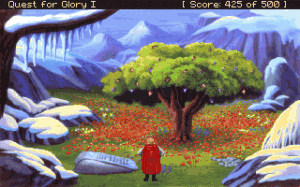 Watch the 2006 TED talk by David Perry shown below, and ask yourself if you’ve ever been emotionally impacted by a video game. For me, the answer is clear. I still reflect fondly on the hours upon hours I spent playing and replaying my old adventure and otherwise plot-driven games like King’s Quest, Quest for Glory, Indiana Jones and the Fate of Atlantis, Wing Commander, and others. I’ve always had an affinity for this type of game, where storylines drive the player to work their way through complex situations. Once the problems in the game are solved, the player emerges with very real feelings of satisfaction and accomplishment, knowing they have affected the progression of the story in some way, even if behind the scenes the game’s direction is more linear than open-ended. Often these stories convey very meaningful, thought-provoking, and emotion-evoking situations. I remember shedding a few tears at the end of Grim Fandango, and getting lost in the immersive worlds of Final Fantasy. As Perry says in his talk, a well-designed game will “seamlessly weave the user in the fabric of the virtual experience,” and that exactly what games have done for me.
Watch the 2006 TED talk by David Perry shown below, and ask yourself if you’ve ever been emotionally impacted by a video game. For me, the answer is clear. I still reflect fondly on the hours upon hours I spent playing and replaying my old adventure and otherwise plot-driven games like King’s Quest, Quest for Glory, Indiana Jones and the Fate of Atlantis, Wing Commander, and others. I’ve always had an affinity for this type of game, where storylines drive the player to work their way through complex situations. Once the problems in the game are solved, the player emerges with very real feelings of satisfaction and accomplishment, knowing they have affected the progression of the story in some way, even if behind the scenes the game’s direction is more linear than open-ended. Often these stories convey very meaningful, thought-provoking, and emotion-evoking situations. I remember shedding a few tears at the end of Grim Fandango, and getting lost in the immersive worlds of Final Fantasy. As Perry says in his talk, a well-designed game will “seamlessly weave the user in the fabric of the virtual experience,” and that exactly what games have done for me.
This is an aspect which must drive how we design all educational games. Not necessarily to the point where students are sobbing uncontrollably while they play, but presenting them with the opportunity to totally immerse themselves in the game, and tapping into what makes games such a unique form of learning: their ability to dig deeper into our minds and emotions that traditional learning media cannot reach.
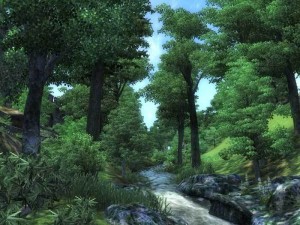 Gaming has shaped our culture, and how we see things. I identify with Michael Highland’s video shown in Perry’s talk, where he says, “When I’m driving down a road at sunset, I think this is almost as beautiful as my games are.” It’s been four years since I last played Oblivion, but every time I see a beautiful scene, such as fog covering the Wasatch Mountains, or the colorful landscape of Bryce Canyon, I instantly think, “This is just as beautiful as Oblivion.” Video games are adept at shaping and reprogramming our minds. The key is to use this for good, and use games to shape the brains of students in such a way that cannot be done with traditional media.
Gaming has shaped our culture, and how we see things. I identify with Michael Highland’s video shown in Perry’s talk, where he says, “When I’m driving down a road at sunset, I think this is almost as beautiful as my games are.” It’s been four years since I last played Oblivion, but every time I see a beautiful scene, such as fog covering the Wasatch Mountains, or the colorful landscape of Bryce Canyon, I instantly think, “This is just as beautiful as Oblivion.” Video games are adept at shaping and reprogramming our minds. The key is to use this for good, and use games to shape the brains of students in such a way that cannot be done with traditional media.
Geo Quest
0Here’s a simple “culture quest” for Geo Island, a region in Second Life dedicated to the study of geology. Interactive models, slideshows, and informational posters are available to guide students through topics relevant to earth science study.
http://maps.secondlife.com/secondlife/Geo Island/140/62/504/
Begin your journey by heading north. Read all the posters you see. What are silicates? What percentage of minerals are silicates, and how much of the Earth’s crust is made up of them? What are the 7 listed types of crystal systems?
After you’ve explored this area, head to the western part of the region. Find the model of “Normal Faults” and touch it to see what happens. Look at the representation of rock layers. What is the difference between DIP and STRIKE?
Go to the far southeast area of the region. View all the slides. Describe the types of weathering. Where was the magnetic north pole 500 million years ago? On the Mohs Hardness scale, which mineral is listed as the softest, and which is the hardest?




Social Presence and Immersive Environments
2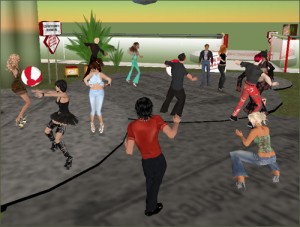 Virtual worlds are considered immersive environments, and as such, it’s not unexpected that the element of social presence plays a rather important role. Virtual worlds have an advantage over traditional forms of distance learning in this area, since the avatar is represented by many of the familiar visual and social cues humans are used to. In Aragon (2003), social presence is defined as the “degree of salience of the other person in the interaction and the consequent salience of the interpersonal relationships” (p. 59). Immediacy, or the “measure of psychological distance that a communicator puts between himself or herself and the object of his/her communication,” can be conveyed by physical proximity formality of dress, physical proximity, facial expressions, and other nonverbal cues, as well as verbal (p. 59). This can apply directly to virtual worlds, since players are given control of all these social conveyances, and it is important because it lends to the immersion of the game.
Virtual worlds are considered immersive environments, and as such, it’s not unexpected that the element of social presence plays a rather important role. Virtual worlds have an advantage over traditional forms of distance learning in this area, since the avatar is represented by many of the familiar visual and social cues humans are used to. In Aragon (2003), social presence is defined as the “degree of salience of the other person in the interaction and the consequent salience of the interpersonal relationships” (p. 59). Immediacy, or the “measure of psychological distance that a communicator puts between himself or herself and the object of his/her communication,” can be conveyed by physical proximity formality of dress, physical proximity, facial expressions, and other nonverbal cues, as well as verbal (p. 59). This can apply directly to virtual worlds, since players are given control of all these social conveyances, and it is important because it lends to the immersion of the game.
What’s interesting, however, is that some research suggests the human interface control is not as relevant as one might think. A study in Aymerich-Franch (2010) revealed that participants who played a game by using their whole body did not experience any significant difference in presence or emotions than participants who played with a joystick. This implies that body-dependent systems such as the Wii and Kinect may not necessarily be more “immersive” to players, if we define immersion as a combination of social presence and emotions, and that we should look to other attributes when determining what makes one game more immersive than another. I would suggest that we should look more at the content of the virtual environment itself, than the human interface used to connect to it.
In another article by Lin (2010), an exploration of gender differences on game enjoyment is examined, as well as personal identification with the character. I feel this article misses the point, particularly when it claims that players are more likely to enjoy a game when the character they are playing is “morally justified” in the story or plot. In other words, a hero fighting for some sort of moral good. This seems logical, until one realizes that some of the top selling games like Grand Theft Auto don’t fit this mold, though one could argue that much of the villainous violence in these games follow a storyline causing the player to sympathize with the character. The genius of games like World of Warcraft is that both sides have sympathetic characters and heroes, and reasons for engaging the rival. The article sidesteps this issue by admitting that yes, some players are the opposite — even a significant number — and attempts to explain why. It seems self-contradictory.
I’ve been sporadically on Second Life since 2005, though only started taking it seriously since 2010, taking time to identify important locations, learn some scripting, and so on. I figured this was all worthy of a “rebirth” so I ditched my old character and created a new one. I think Second Life profiles are an important, yet perhaps underused element of social presence in a virtual world. They can serve to tie the avatar to a real user behind the screen.
People are a lot more prone to do things in Second Life they wouldn’t normally do in person. This is really nothing new, and applies to virtually all communication on the Internet. I think there is a degree of accountability that comes into play and prevents some severely offensive behavior when avatars are specifically identified with real people, but when there is full anonymity, it is rather chaotic and anarchic.
References
Aragon, S. R. (2003). Creating social presence in online environments. New Directions for Adult and Continuing Education, 2003(100), 57-68.
Aymerich-Franch, L. (2010). Presence and emotions in playing a group game in a virtual environment: The influence of body participation. Cyberpsychology, Behavior, and Social Networking, 13(6), 649-654.
Lin, S. (2010). Gender differences and the effect of contextual features on game enjoyment and responses. Cyberpsychology, Behavior and Social Networking, 13(5), 533-537.

Sculpties and Meshes in Second Life and OpenSim
2Imagine a drafting class. Students are designing buildings in AutoCAD, laying out blueprints, and modeling the architectures. The teacher then tells everyone, “Okay, now add your buildings to the virtual city.” The students save their files, load up a program, and import the models into a virtual world. Within a few minutes, the world changes from a blank landscape to a rudimentary, populated town. The teachers and students can now walk around the town, examine the buildings, note areas needing improvement (“this wall’s bigger than the other” or “the ceiling here is lacking structural support”), and participate in a collaborative environment where teachers give prompt feedback to the group, and students can share their work with their peers.
It’s just one of many practical uses of virtual worlds in an educational setting, which goes beyond simply exploring the environment, to actually constructing content that can be assessed and evaluated. However, being able to import models constructed in third party utilities requires some additional work.
In Second Life and OpenSim, content is made using primitives: basic building blocks consisting of boxes, cylinders, cubes, pyramids, etc. that can be twisted, stretched, and otherwise manipulated, then linked to other primitives to create sophisticated objects. The method has a fairly low learning curve, but is limiting in how detailed models can be.
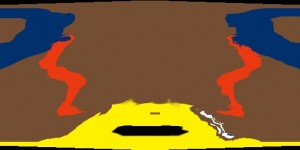
The texture map for the "sculptie"

An example of a "sculptie" image
Second Life and OpenSim also support “sculpties.” Sculpties are 3d models derived from colored graphic maps. In OpenSim, you can import terrain files composed of grayscale images. White indicates the highest elevations, while black indicates the lowest elevations. Sculptie maps are kind of like that, except with the additional colors more detail can be passed into the program to represent complex 3d models.
I’ve had mixed results with sculptie creation, particularly in OpenSim. At best, the tools for easily creating them are overly simplistic and don’t contain the features many students would probably require. At worst, the setup for sculptie support is more complicated than it should be. It’s certainly doable, but we have to keep in mind the less technical teachers and students when integrating this technology into the classroom, and the last thing we want is a teacher spending an inordinate amount of time trying to cross the bridge between the 3d modeling software and the virtual world.
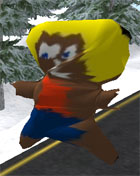
The same model in OpenSim
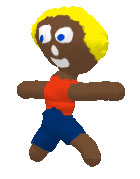
A model made in Plopp SL
One tool I found intriguing is Plopp SL, a very easy-to-use program for simple 3d modeling and sculptie creation, aimed at young kids. Most modeling programs use a simulated three-dimensional space for sculpting objects, but Plopp SL allows users to just draw their objects the traditional pencil way, and the program then “inflates” the object like a balloon so it takes on a three-dimensional quality.
After that, you can export the sculptie map and the texture map, and load them up in OpenSim with the Imprudence Viewer (soon to be the Kokua Viewer). However, when I tried this, I ran into some problems when I tried importing the model. Shown here is an example of a doll I made in Plopp SL, which created the above sculptie textures, and how it looks in OpenSim itself. As you can see, it doesn’t quite render correctly in OpenSim. Maybe there’s some configuration setting that needs to be tweaked, but needless to say, I’m not entirely thrilled with sculpties after these experiments.
However, Second Life and OpenSim have now added basic support for meshes. A mesh is a collection of different shapes that make up a whole object. In most 3d modeling applications these are developed using wireframe models. Both virtual world applications still have a ways to go, but progress is being rapidly made.
So why do we want meshes instead of sculpties? Manipulating and linking primitives together has allowed the creation of some amazing work in Second Life/OpenSim, but there’s tremendous value to being able to create models using standard industry tools. Meshes allow direct compatibility with third-party 3d modeling programs our students use like Maya, Sketchup, and AutoCAD. All a student has to do is save their model in Maya (in the COLLADA format), and upload it directly through the Second Life viewer.
Other open source virtual world applications such as realXtend, a fork of OpenSim, and Open Wonderland have had mesh support for a long time. But Second Life Viewer 2 is the first Second Life viewer to support the mesh environment. OpenSim is not fully compatible with it yet, but it’s getting there. The Kokua project is building a new viewer based on Second Life Viewer 2. It has a sleeker interface than the old viewer upon which others like Imprudence, Hippo, and Phoenix are based. support. Kokua is the successor to Imprudence, and will be incorporating many new features, while remaining fully compatible with OpenSim and Second Life.
I believe there will be value to allowing our students to access Second Life in the future, so having a viewer compatible with both Second Life and OpenSim will be important. This may involve modifying the viewer with a whitelist of acceptable regions, or putting some other filtering utilities in place, but gaining access to the learning opportunities in Second Life will become an invaluable asset in our students’ future learning. This is one thing which prevents me from adopting realXtend. Which it is immensely cool, feature-rich, and visually appealing, it is heading in a different direction than OpenSim. It has its own viewer which is not compatible with Second Life, although the ModRex project aims to allow realXtend-OpenSim compatibility. It is still new, and whether that will translate to Second Life remains to be seen.
A demo of realXtend’s mesh and animation capabilities. Looks quite a bit better than Second Life/OpenSim, doesn’t it?
Getting Rid of Groupwise
We are currently in the process of migrating our email system from Novell Groupwise to Microsoft Exchange. This is going to be a huge transition, but we’ll be able to do it with no downtime for the teachers and students, and the migration should be pretty smooth. Many of the new features will be very cool, particularly the new Lync Messenger which will replace Groupwise Messenger.
Check out this presentation that was delivered to administrators detailing some of the aspects of this migration.

